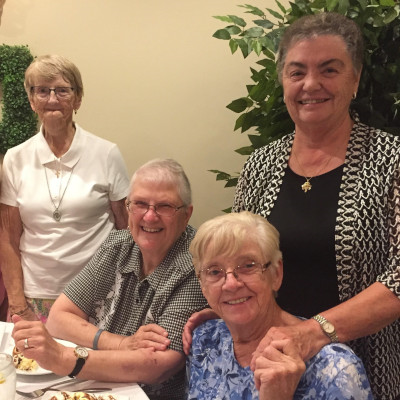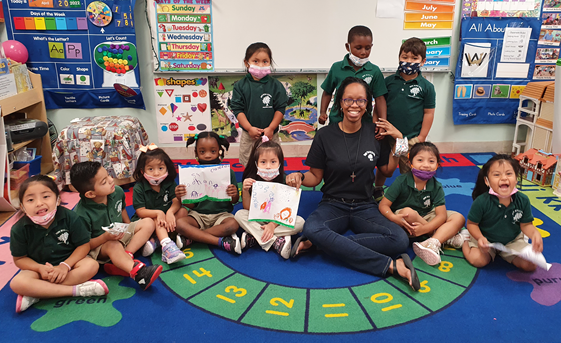I recently had the opportunity to
visit my Sinsinawa Dominican Sisters (Srs.
Elizabeth Dunn OP, Martha Mary Rohde OP and Barbara Becker OP) in
Indiantown, Florida for a ministry experience. During my short stay in Florida,
I accompanied my Sisters to their ministries in Indiantown, where I encountered
those to whom they ministered, and volunteered my services. Srs. Elizabeth and
Martha Mary worked at “Hope Rural School” as executive director and principal
respectively. Sr. Barbara worked at the “KinDoo Family Center” as the child
care coordinator.
Brief
background on the area
Indiantown is a small town in
Florida that was named after the Seminole Indians, who made it their campsite
over one hundred years ago (Ashabranner, 1986). This rural town is located
thirty miles from West Palm Beach. For decades, Indiantown has been home for
migrants and immigrant farm workers, who continue to claim it as a refuge from
economic hardships and civil wars in their countries (Dooley, 2010). Indiantown
houses a diverse population of persons from Mexico, Guatemala, Haiti, Puerto
Rico and the United States (Dooley, 2010).
Brief
history of the Hope Rural School
In the late 1970s, a group of
concerned residents wanted to provide education for children of migrant farm
workers (Dooley, 2010). “Language deficiencies and cultural differences” made
school challenging for migrant children (Dooley, 2010). In addition, children
of migrant farm workers generally missed school during the school year (from
April to September) because their parents travelled to different places where
crops (such as apples, cherries, peaches, onions and oranges) were ready to be
picked.
In 1980, Father Frank O’Loughlin
and Sister Carol Putman, RSCJ founded and incorporated Hope Rural School, with
the support of the community, in order to provide the children of
migrant/immigrant farm workers with a Catholic elementary education. “The
school day was extended into the late afternoon to assist parents whose working
days often lasted until evening. Teachers focused on the basics of the
curriculum with an emphasis on language development and assisted students with
practical adjustments to the society and culture of the United States” (Dooley,
2010).
Today, Hope Rural School
continues to primarily serve children from immigrant families. It supports,
guides and encourages the entire family through the education of children,
parenting classes and English classes for Adults (Hope Rural School, 2017). As
a fully accredited institution, it fulfils its mission to offer families hope
by providing a catholic elementary education to children in grades PreK3
through grade 5. The school fosters a safe, stimulating and nurturing
environment that promotes gospel values.
Over the years, many communities
of religious sisters have supported the Hope Rural School, particularly, the
Religious Sisters of the Sacred Heart, the Sisters of Charity from Cincinnati,
the School Sisters of Notre Dame and the Dominican Sisters of Sinsinawa.
Brief
History of KinDoo Family Center
The co-directors of KinDoo Family
Centre, Sisters Mary Dooley, SSND and Kate Kinnally, SSND worked as
administrators of the Hope Rural School for many years. They recognized that
parents were learning English at a relatively slower pace than their children
and many of them relied heavily on their children to translate for them. in
addition, many of the Guatemalan, Mexican and Haitian immigrant families had
little opportunity for schooling in their countries prior their arrival in the
United States.
The KinDoo Family Center opened
for classes in October 2015. Its mission involves empowering families with life
skills that will enable them to achieve a better life. KinDoo’s programs
currently include sewing, literacy, nutrition and cooking, art, computer and
Kids Korner. Sister Barbara helps to provide childcare services while parents
attend classes.
KinDoo’s Adult Literacy Program
provides English language instruction that helps parents to gain the skills,
knowledge and motivation needed to read and write independent of their
children; become employed; and pursue further education. Weekly Cooking,
Nutrition and Conversation classes help women to adopt healthier lifestyles,
which improves their health outcomes, their sense of well-being and their
self-esteem (Kin Doo Family Services, 2022). The sewing program empowers the
students to provide for their families and to positively impact their
communities by sharing their gifts.
My
ministry experience
This rich history is the context
in which I started my ministry experience. As I entered the Hope Rural School,
I was warmly greeted by the children and the staff. The “little hopes”, the 3
and 4 year-olds, enthusiastically surrounded me. The school had a diverse
student population. In addition, the grounds of the school were beautiful and
conducive to learning. I really appreciated that the school provided breakfast
and lunch for all of the students so that they would all have the nutrients
that they needed to be productive. Many of the little hopes seemed to speak
mostly Spanish. It was helpful that some the teachers and assistants were
fluent in both Spanish and English. The children learnt English as part of the
school curriculum. In addition, reading was greatly encouraged as a source of
learning. Their reading resource room was filled with fun and engaging books.
Additional support was given for children who were progressing at a slower
pace. There was also a peer system where older children would read to the
younger children.
I was delighted to discover that
the hope rural school catered to children with different learning styles.
Material was presented and reinforced in varied ways. I provided additional
support for teachers and assistants. I also assisted with physical education
and revision of concepts. Much of my time was spent with the PreK3 students.
Their teacher, Mrs. Kendly Lopez and assistant teacher, Ms. Angelica Mendoza helped to create a very welcoming atmosphere.
I really appreciated that as early as 3 years, the children were encouraged to
choose the ways in which they wanted to revise a concept (for example, though
song, a story, or an activity that engaged their entire bodies).
The children also learned about
different countries in the world. I did a presentation on Trinidad and Tobago
in order to provide the children with some information about my country. They
were engaged and readily answered my questions. I was pleasantly surprised to
find out that the children had previously learnt about Trinidad and Tobago a
few years ago. Moreover, approximately once a month, a class is responsible for
creatively showcasing what they had studied. The preK4s competently and
enthusiastically displayed their skills in counting, adding (using their
fingers), singing and advocating for care of the earth. I was also very impressed
when they narrated the Passion of Christ. Each student remembered his or her
lines and his or her place in the narrative. They also boldly shared their
dream for their future careers (for example, a singer, astronaut, nurse, police
offer or teacher). The rest of the
school, the staff and the children’s parents and guardians enthusiastically
supported the preK4 class. I was so pleased to see the proud parents and
guardians taking pictures and applauding their children’s efforts during the
term.
In some instances, I was learning along with
the children. On one such occasion, I had accompanied the children of grades 3
to 5 with their teachers and other volunteers to the Environmental Studies
Centre. There were interactive presentations to prepare us for the organisms
that we would encounter in the sea later that day. The 4th graders
were introduced to the mangroves and were taught to distinguish red, black and
white mangroves. The 3rd graders and the 5th graders went
seining, which involves using a fishing net (which
is placed vertically in the water with floats at the top) to encircle the fish,
shrimp, crabs, for example. These budding scientists learnt how to record and
handle their findings. They were also introduced to the circle of life. They
returned any organism that was carrying eggs back into the ocean and used the
rest of their catch as live bait, for the fishes and lobsters that were housed
at the centre.
I also had an opportunity to
visit the KinDoo Family Center during their Volunteer Appreciation Day. As I
entered, I recognized that the students were diligently practicing enunciating
their English words using their respective scripts. I was also introduced to
the children that Sr. Barbara taught at Kids Korner. The children appeared to
be happy and energetic as they engaged with the toys. The KinDoo women creatively
offered vote of thanks to their teachers. Some were wearing beautiful dresses
they had sewn. They humbly served us a delicious and nutritious meal that they
had prepared with their teacher. I was delighted by the beautiful and
professional display of yummy desserts.
The fresh vegetables used in our
meal were grown and harvested from the community garden. Residents of the area
were gifted with a plot in the community garden. They were responsible for
tending to their garden. I accompanied Sr. Barbara to volunteer at the
community garden and I encountered some of the KinDoo women and their children
there. Residents were removing the winter crops to plant the seeds for the “summer
crops”. Seeds were donated and residents were free to take them and plant them.
I observed the comradery among residents as they worked alongside each other
and shared crops with each other.
Reflections
I am truly thankful for this
ministry experience. The Hope Rural School and the KinDoo Family Center have
supported many families through the gift of education. They provide a safe,
stimulating and respectful atmosphere for all persons. The sisters and other
members of the local community freely offer their time, talent and treasure to
empower those whom they serve so that they can have more positive outcomes. They
model for their students the value of hard work, community and “dreaming big”.
Students are given the necessary skills and support to find gainful employment
and to pursue advanced education.
The vision and mission of both of
these institutions are fulfilled each day. As I continue to my discernment of
vows at the CDN, I am reminded that my “yes” is intended to make me more
available to God and service to God’s people. As I listen for God’s direction regarding
my next ministry, I am reminded to ‘dream big’, work hard and rely on the
support of community to courageously serve those in need, in the ways God calls
me. In so doing, I can also help God’s people to have more positive outcomes by
God’s grace.
Photos
(Left Picture) Sinsinawa Sisters who have worked at Hope Rural School: (from the left) Sr. Martha Rohde, OP, Sr. Elizabeth Dunn, OP and Sr. Marie Celeste Gatti, OP.
(Right Picture): Past and Present Administrators of Hope Rural School: (from the left) Sr. Kate Kinnally, SSND, Sr. Martha Rohde, OP, Sr. Elizabeth Dunn, OP, Sr. Mary Dooley, SSND.
Photos of my ministry with the PreK3 class















No comments:
Post a Comment